Neutralisation reactions (ESCP9)
A cation is an ion (charged atom or molecule) with a positive (+)
charge. An anion is an ion with a negative (-) charge.
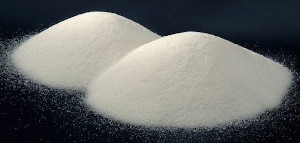
Salts are not just the table salt you put on your food. A salt is any compound made
up of stoichiometrically equivalent amounts of cations and anions to make a
neutral, ionic compound.
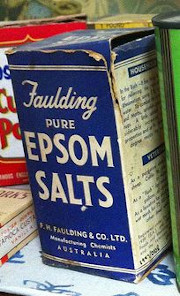
Magnesium sulfate heptahydrate (\(\text{MgSO}_{4}.7\text{H}_{2}\text{O}\)), commonly
known as Epsom salt, can be used as a gel to treat aches and pains, as bath
salts, and has many other uses.
When an equivalent amount of acid and base react (so that neither the acid nor the base are
in excess), the reaction is said to have reached the equivalence point.
At this point neutralisation has been achieved.
- Equivalence point
-
When a stoichiometrically equivalent number of moles of both reactants has
been added to the reaction vessel.
To better understand stoichiometric equivalence look at the following equations:
-
\(1\color{red}{\text{HA(aq)}} + 1\color{blue}{\text{BOH(aq)}} \to\)
\(1\text{AB}(\text{aq}) + 1\text{H}_{2}\text{O}(\text{ℓ})\)
-
\(1\color{red}{\text{H}_{2}{\text{A(aq)}}} + 2\color{blue}{\text{BOH(aq)}}
\to\) \(1\text{AB}_{2}(\text{aq}) +
2\text{H}_{2}\text{O}(\text{ℓ})\)
In the first example above, a stoichiometrically equivalent number of moles is
one mole of \(\color{red}{\text{HA}}\) for every one
mole of \(\color{blue}{\text{BOH}}\). In the second example, a stoichiometrically
equivalent number of moles is one mole of
\(\color{red}{\text{H}_{2}{\text{A}}}\) for every two moles of
\(\color{blue}{\text{BOH}}\).
- Neutralisation
-
A neutralisation reaction involves an acid and a base reacting to form a
salt.
Look at the following examples:
-
Hydrochloric acid with sodium hydroxide
Hydrochloric acid reacts with sodium hydroxide to form sodium chloride (the
salt) and water. Sodium chloride is made up of \(\text{Na}^{+}\) cations
from the base \((\text{NaOH})\) and \(\text{Cl}^{-}\) anions from the
acid \((\text{HCl})\).
\(\text{H}{\color{red}{\textbf{Cl}}}{\text{(aq)}} +
\color{blue}{\textbf{Na}}{\text{OH(aq)}} \to
{\color{blue}{\textbf{Na}}}{\color{red}{\textbf{Cl}}}{\text{(aq)}} +
{\text{H}}_{2}{\text{O(ℓ)}}\)
-
Hydrogen bromide with postassium hydroxide
Hydrogen bromide reacts with potassium hydroxide to form potassium bromide
(the salt) and water. Potassium bromide is made up of \(\text{K}^{+}\)
cations from the base \((\text{KOH})\) and \(\text{Br}^{-}\) anions from
the acid \((\text{HBr})\).
\(\text{H}{\color{red}{\textbf{Br}}}{\text{(aq)}} +
\color{blue}{\textbf{K}}\text{OH(aq)} \to
\color{blue}{\textbf{K}}\color{red}{\textbf{Br}}{\text{(aq)}} +
{\text{H}}_{2}\text{O(ℓ)}\)
-
Hydrochloric acid with sodium hydrocarbonate
Hydrochloric acid reacts with sodium hydrocarbonate to form sodium chloride
(the salt), water and carbon dioxide. Sodium chloride is made up of
\(\text{Na}^{+}\) cations from the base \((\text{NaHCO}_{3})\) and
\(\text{Cl}^{-}\) anions from the acid \((\text{HCl})\).
\(\text{H}{\color{red}{\textbf{Cl}}}{\text{(aq)}} +
{\color{blue}{\textbf{Na}}}{\text{HCO}}_{3}{\text{(aq)}} \to
\color{blue}{\textbf{Na}}\color{red}{\textbf{Cl}}{\text{(aq)}} +
{\text{H}_{2}{\text{O(ℓ)}}} + {\text{CO}}_{2}{\text{(g)}}\)
You should notice that in the first two examples, the base contained \(\text{OH}^{-}\) ions,
and therefore the products were a salt and water. \(\text{NaCl}\)
(table salt) and \(\text{KBr}\) are both salts. In the third example,
\(\text{NaHCO}_{3}\) also acts as a base, despite not having \(\text{OH}^{-}\) ions. A
salt is still formed as one of the products, but carbon dioxide (\(\text{CO}_{2}\)) is
produced as well as water.
This experiment can be used for an informal assessment. It will help determine if the
learners understand what happens in a neutralisation reaction. Learners are
working with a strong acid and a strong base in this reaction. Concentrated,
strong acids and bases can cause serious burns. Please remind the learners to be
careful and wear the appropriate safety equipment when handling all chemicals,
especially concentrated acids and bases. The safety equipment includes gloves,
safety glasses, and protective clothing.
Salts can come in many different colours.
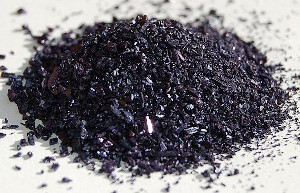
\(\color{purple}{\textbf{Potassium permanganate}}\)
(\(\color{purple}{\textbf{KMnO}_{4}}\))
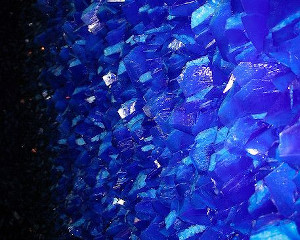
\(\color{blue}{\textbf{Copper sulfate}}\) (\(\color{blue}{\textbf{CuSO}_{4}}\))
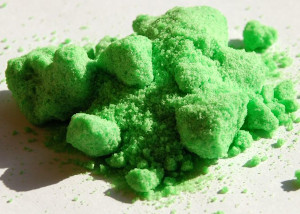
\(\color{darkgreen}{\textbf{Nickel chloride}}\)
(\(\color{darkgreen}{\textbf{NiCl}_{2}}\))
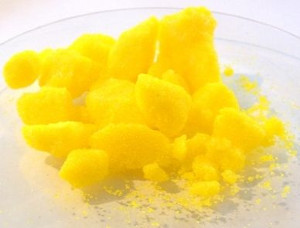
\(\color{gold}{\textbf{Sodium chromate}}\)
(\(\color{gold}{\textbf{Na}_{2}{\textbf{CrO}}_{4}}\))
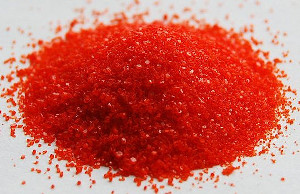
\(\color{red}{\textbf{Potassim dichromate}}\)
(\(\color{red}{\textbf{K}_{2}{\textbf{Cr}}_{2}{\textbf{O}}_{7}}\))
Neutralisation reactions are very important in every day life. Below are some examples:
-
Domestic uses
Calcium oxide \((\text{CaO})\) is used to neutralise acidic soil. Powdered
limestone \((\text{CaCO}_{3})\) can also be used, but its action is much
slower and less effective. These substances can also be used on a larger
scale in farming and in rivers.
-
Biological uses
Hydrochloric acid \((\text{HCl})\) in the stomach plays an important role in
helping to digest food. It is important to note that too much acid in
the stomach may lead to the formation of ulcers in cases where the
stomach lining is damaged (e.g. by an infection).
Antacids (which are bases) are taken to neutralise excess
stomach acid, to prevent damage to the intestines. Examples of antacids
are aluminium hydroxide, magnesium hydroxide ('milk of magnesia') and
sodium bicarbonate ('bicarbonate of soda').
-
Industrial uses
Alkaline calcium hydroxide (limewater) is used to absorb harmful acidic
\(\text{SO}_{2}\) gas that is released from power stations and from the
burning of fossil fuels.
Please do not use a base to neutralise an acid if you spill some on
yourself during an experiment. A strong base can burn you as much as a strong
acid. Rather wash the area thoroughly with water.
Bee stings are acidic and have a pH between \(\text{5}\) and \(\text{5,5}\). They can
be soothed by using substances such as calomine lotion, which is a mild alkali
based on zinc oxide. Bicarbonate of soda, or soap, can also be used. The alkalis
help to neutralise the acidic bee sting and relieve some of the itchiness.
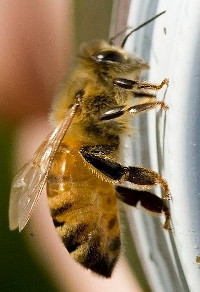
Acids and metal compounds
Research the reactions that occur when an acid is added to the
following compounds:
(Your Grade 11 book will be helpful with this research)
Write a report which includes:
-
The general equation (in words) of each reaction.
-
A description of what is happening in this reaction.
-
An example of this type of reaction in the form of a balanced
equation.
The following is an example of how the learners acids and metals compounds
report could look:
-
Acid + metal \(\to\) salt +
hydrogen
A dilute acid is added to a pure metal to form a salt and hydrogen
gas. The salt is formed by the metal cation and the anion from
the acid. In this reaction the metal is acting as a base. For
example:
\(\color{red}{\text{hydrochloric acid}} + \color{blue}{\text{zinc}}
\to \color{blue}{\text{zinc}} \color{red}{\text{ chloride}}\) +
hydrogen
\(2\text{HCl}(\text{aq}) + \text{Zn}(\text{s})\) \(\to\)
\(\text{ZnCl}_{2}(\text{aq}) + \text{H}_{2}(\text{g})\)
-
Acid + metal hydroxide \(\to\) salt +
water
A dilute acid is added to a metal hydroxide to form a salt and water.
The salt is formed by the metal cation and the anion from the
acid. In this reaction the metal hydroxide is acting as a base.
For example:
\(\color{red}{\text{hydrochloric acid}} + \color{blue}{\text{zinc
hydroxide}} \to \color{blue}{\text{zinc}} \color{red}{\text{
chloride}}\) + water
\(2\text{HCl}(\text{aq}) + \text{Zn}(\text{OH})_{2}(\text{s})\)
\(\to\) \(\text{ZnCl}_{2}(\text{aq}) +
2\text{H}_{2}\text{O}(\text{ℓ})\)
-
Acid + metal oxide \(\to\) salt +
water
A dilute acid is added to a metal oxide to form a salt and water. The
salt is formed by the metal cation and the anion from the acid.
In this reaction the metal oxide is acting as a base. For
example:
\(\color{red}{\text{hydrochloric acid}} + \color{blue}{\text{zinc
oxide}} \to \color{blue}{\text{zinc}} \color{red}{\text{
chloride}}\) + water
\(2\text{HCl}(\text{aq}) + \text{ZnO}(\text{s})\) \(\to\)
\(\text{ZnCl}_{2}(\text{aq}) +
\text{H}_{2}\text{O}(\text{ℓ})\)
-
Acid + metal carbonate \(\to\) salt + water
+ carbon dioxide
A dilute acid is added to a metal carbonate to form a salt, water and
carbon dioxide gas. The salt is formed by the metal cation and
the anion from the acid. In this reaction the metal carbonate is
acting as a base. For example:
\(\color{red}{\text{hydrochloric acid}} + \color{blue}{\text{zinc
carbonate}} \to \color{blue}{\text{zinc}} \color{red}{\text{
chloride}}\) + water + carbon dioxide
\(2\text{HCl}(\text{aq}) + \text{ZnCO}_{3}(\text{s})\) \(\to\)
\(\text{ZnCl}_{2}(\text{aq}) +
\text{H}_{2}\text{O}(\text{ℓ}) +
\text{CO}_{2}(\text{g})\)
-
Acid + metal hydrogen carbonate \(\to\) salt
+ water + carbon dioxide
A dilute acid is added to a metal hydrogen carbonate to form a salt,
water and carbon dioxide gas. The salt is formed by the metal
cation and the anion from the acid. In this reaction the metal
hydrogen carbonate is acting as a base. For example:
\(\color{red}{\text{hydrochloric acid}} + \color{blue}{\text{zinc
bicarbonate}} \to \color{blue}{\text{zinc}} \color{red}{\text{
chloride}}\) + water + carbon dioxide
\(2\text{HCl}(\text{aq}) + \text{Zn}(\text{HCO}_{3})_{2}(\text{s})\)
\(\to\) \(>\text{ZnCl}_{2}(\text{aq}) +
2\text{H}_{2}\text{O}(\text{ℓ}) +
2\text{CO}_{2}(\text{g})\)
The hazardous nature of acids and bases
Search for information about the following strong acids and bases:
-
Hydrochloric acid (\(\text{HCl}\))
-
Sulfuric acid (\(\text{H}_{2}\text{SO}_{4}\))
-
Sodium hydroxide (\(\text{NaOH}\))
-
Potassium hydroxide (\(\text{KOH}\))
Write a report which includes:
-
The uses of these compounds in industry
-
If applicable, the environmental waste that contains these compounds
-
What the effect of a large spillage of these compounds would be
The following is an example of the sort of information learners should report on:
Hydrochloric acid
Hydrochloric acid is used industrially to clean rust from iron or steel as well as in
the refining of ores. If released into the environment hydrochloric acid will
lower the pH of any water it pollutes. This change in pH can seriously affect
the growth of plants and damage ecosystems.
Worked example 8: Determining equations from starting materials
Magnesium carbonate (\(\text{MgCO}_{3}\)) is dissolved in nitric acid
(\(\text{HNO}_{3}\)). Give the balanced chemical equation for this
reaction.
What are the reactants?
An acid (\(\text{HNO}_{3}\)) and a metal carbonate (\(\text{MgCO}_{3}\)).
What will the products be?
As this is the reaction of an acid and a metal carbonate the products will be
a salt, water and carbon dioxide.
nitric acid + magnesium carbonate \(\to\) salt + water + carbon dioxide
What is the formula of the salt?
The cation will come from the metal carbonate (\(\text{Mg}^{2+}\)). The anion
will come from the acid (\(\text{NO}_{3}^{-}\)). Due to the charges on
the cation and anion there must be two \(\text{NO}_{3}^{-}\) for every
one \(\text{Mg}^{2+}\).
Therefore the formula for the salt will be: \(\text{Mg}(\text{NO}_{3})_{2}\).
Write the equation for this reaction
\(\text{HNO}_{3}(\text{aq}) + \text{MgCO}_{3}(\text{s})\) \(\to\)
\(\text{Mg}(\text{NO}_{3})_{2}(\text{aq}) +
\text{H}_{2}\text{O}(\text{ℓ}) + \text{CO}_{2}(\text{g})\)
Make sure that the equation is balanced
The equation is not balanced.
|
Number on left
|
Number on right
|
|
H
|
\(\text{1}\)
|
\(\text{2}\)
|
|
N
|
\(\text{1}\)
|
\(\text{2}\)
|
|
O
|
\(\text{6}\)
|
\(\text{9}\)
|
|
Mg
|
\(\text{1}\)
|
\(\text{1}\)
|
|
C
|
\(\text{1}\)
|
\(\text{1}\)
|
To balance this equation there needs to be two nitric acid molecules on the
left hand side.
\(2\text{HNO}_{3}(\text{aq}) + \text{MgCO}_{3}(\text{s})\) \(\to\)
\(\text{Mg}(\text{NO}_{3})_{2}(\text{aq}) +
\text{H}_{2}\text{O}(\text{ℓ}) + \text{CO}_{2}(\text{g})\)
|
Number on left
|
Number on right
|
|
H
|
\(\text{2}\)
|
\(\text{2}\)
|
|
N
|
\(\text{2}\)
|
\(\text{2}\)
|
|
O
|
\(\text{9}\)
|
\(\text{9}\)
|
|
Mg
|
\(\text{1}\)
|
\(\text{1}\)
|
|
C
|
\(\text{1}\)
|
\(\text{1}\)
|
The equation is now balanced.
Worked example 9: Determining equations from starting materials
Hydroiodic acid (\(\text{HI}\)) is added to solid potassium hydroxide
(\(\text{KOH}\)). Give the balanced chemical equation for this reaction.
What are the reactants?
An acid (\(\text{HI}\)) and a base (\(\text{KOH}\)).
What will the products be?
As this is the reaction of an acid and base (which contains a hydroxide
anion) the products will be a salt and water.
hydroiodic acid + potassium hydroxide \(\to\) salt + water
What is the formula of the salt?
The cation will come from the base (\(\text{K}^{+}\)). The anion will come
from the acid (\(\text{I}^{-}\)). Due to the charges on the cation and
anion there must be one \(\text{K}^{+}\) for every one \(\text{I}^{-}\).
Therefore the formula for the salt will be: \(\text{KI}\).
Write the equation for this reaction
\(\text{HI}(\text{aq}) + \text{KOH}(\text{s})\) \(\to\)
\(\text{KI}(\text{aq}) + \text{H}_{2}\text{O}(\text{ℓ})\)
This can also be written:
\(\text{HI}(\text{aq}) + \text{KOH}(\text{s})\) \(\to\)
\(\text{K}^{+}(\text{aq}) + \text{I}^{-}(\text{aq}) +
\text{H}_{2}\text{O}(\text{ℓ})\)
Make sure that the equation is balanced
The equation is balanced.
Worked example 10: Determining equations from starting materials
Sulfuric acid (\(\text{H}_{2}\text{SO}_{4}\)) and ammonia (\(\text{NH}_{3}\))
are combined. Give the balanced chemical equation for this reaction.
What are the reactants?
An acid (\(\text{H}_{2}\text{SO}_{4}\)) and a base (\(\text{NH}_{3}\)).
What will the products be?
As this is the reaction of an acid and a base (with no hydroxide anion),
there will be a salt as a product. There may or may not be another
product.
sulfuric acid + ammonia \(\to\) salt (+ maybe another product)
What is the formula of the salt?
The cation will come from the base (\(\text{NH}_{4}^{+}\)). The anion will
come from the acid (\(\text{SO}_{4}^{2-}\)). Due to the charges on the
cation and anion there must be two \(\text{NH}_{4}^{+}\) for every one
\(\text{SO}_{4}^{2-}\).
Therefore the formula for the salt will be:
\((\text{NH}_{4})_{2}\text{SO}_{4}\).
Write the equation for this reaction so far
\(\text{H}_{2}\text{SO}_{4}(\text{aq}) + \text{NH}_{3}(\text{g})\) \(\to\)
\((\text{NH}_{4})_{2}\text{SO}_{4}(\text{aq})\) (+ maybe another
product)
Determine if there will be another product
There are no atom types that are not accounted for on both sides of the
equation, therefore it is unlikely that there will be another product.
If the equation can be balanced then there is no other product.
Make sure that the equation is balanced
The equation is not balanced.
|
Number on left
|
Number on right
|
|
H
|
\(\text{5}\)
|
\(\text{8}\)
|
|
S
|
\(\text{1}\)
|
\(\text{1}\)
|
|
O
|
\(\text{4}\)
|
\(\text{4}\)
|
|
N
|
\(\text{1}\)
|
\(\text{2}\)
|
To balance this equation there needs to be two ammonia molecules on the left
hand side.
\(\text{H}_{2}\text{SO}_{4}(\text{aq}) + 2\text{NH}_{3}(\text{g})\) \(\to\)
\((\text{NH}_{4})_{2}\text{SO}_{4}(\text{aq})\)
|
Number on left
|
Number on right
|
|
H
|
\(\text{8}\)
|
\(\text{8}\)
|
|
S
|
\(\text{1}\)
|
\(\text{1}\)
|
|
O
|
\(\text{4}\)
|
\(\text{4}\)
|
|
N
|
\(\text{2}\)
|
\(\text{2}\)
|
The equation is now balanced.
Reactions of acids and bases
Textbook Exercise 9.4
Hydrochloric acid and calcium
acid (\(\text{HCl}\)) + metal (\(\text{Ca}\)) \(\to\)
salt + hydrogen
Anion (from acid) is \(\text{Cl}^{-}\), cation (from
metal) is \(\text{Ca}^{2+}\).
Therefore salt is \(\text{CaCl}_{2}\).
\(\text{HCl}(\text{aq}) + \text{Ca}(\text{s})\)
\(\to\) \(\text{CaCl}_{2}(\text{aq}) +
\text{H}_{2}(\text{g})\)
To balance this equation there must be two
\(\text{HCl}\) molecules.
\(2\text{HCl}(\text{aq}) + \text{Ca}(\text{s})\)
\(\to\) \(\text{CaCl}_{2}(\text{aq}) +
\text{H}_{2}(\text{g})\)
Nitric acid and magnesium
acid (\(\text{HNO}_{3}\)) + metal (\(\text{Mg}\))
\(\to\) salt + hydrogen
Anion (from acid) is \(\text{NO}_{3}^{-}\), cation
(from metal) is \(\text{Mg}^{2+}\).
Therefore salt is \(\text{Mg}(\text{NO}_{3})_{2}\).
\(\text{HNO}_{3}(\text{aq}) + \text{Mg}(\text{s})\)
\(\to\)
\(\text{Mg}(\text{NO}_{3})_{2}(\text{aq}) +
\text{H}_{2}(\text{g})\)
To balance this equation there must be two
\(\text{HNO}_{3}\) molecules.
\(2\text{HNO}_{3}(\text{aq}) + \text{Mg}(\text{s})\)
\(\to\)
\(\text{Mg}(\text{NO}_{3})_{2}(\text{aq}) +
\text{H}_{2}(\text{g})\)
Hydrochloric acid and magnesium hydroxide
acid (\(\text{HCl}\)) + metal hydroxide
(\(\text{Mg}(\text{OH})_{2}\)) \(\to\) salt +
water
Anion (from acid) is \(\text{Cl}^{-}\), cation (from
metal) is \(\text{Mg}^{2+}\).
Therefore salt is \(\text{MgCl}_{2}\).
\(\text{HCl}(\text{aq}) +
\text{Mg}(\text{OH})_{2}(\text{s})\) \(\to\)
\(\text{MgCl}_{2}(\text{aq}) +
\text{H}_{2}\text{O}(\text{ℓ})\)
To balance this equation there must be two
\(\text{HCl}\) molecules and two
\(\text{H}_{2}\text{O}\) molecules.
\(2\text{HCl}(\text{aq}) +
\text{Mg}(\text{OH})_{2}(\text{s})\) \(\to\)
\(\text{MgCl}_{2}(\text{aq}) +
2\text{H}_{2}\text{O}(\text{ℓ})\)
Nitric acid and aluminium hydroxide
acid (\(\text{HNO}_{3}\)) + metal hydroxide
(\(\text{Al}(\text{OH})_{3}\)) \(\to\) salt +
water
Anion (from acid) is \(\text{NO}_{3}^{-}\), cation
(from metal) is \(\text{Al}^{3+}\).
Therefore salt is \(\text{Al}(\text{NO}_{3})_{3}\).
\(\text{HNO}_{3}(\text{aq}) +
\text{Al}(\text{OH})_{3}(\text{s})\) \(\to\)
\(\text{Al}(\text{NO}_{3})_{2}(\text{aq}) +
\text{H}_{2}\text{O}(\text{ℓ})\)
To balance this equation there must be three
\(\text{HNO}_{3}\) molecules and three
\(\text{H}_{2}\text{O}\) molecules.
\(3\text{HNO}_{3}(\text{aq}) +
\text{Al}(\text{OH})_{3}(\text{s})\) \(\to\)
\(\text{Al}(\text{NO}_{3})_{3}(\text{aq}) +
3\text{H}_{2}\text{O}(\text{ℓ})\)
Hydrochloric acid and aluminium oxide
acid (\(\text{HCl}\)) + metal oxide
(\(\text{Al}_{2}\text{O}_{3}\)) \(\to\) salt +
water
Anion (from acid) is \(\text{Cl}^{-}\), cation (from
metal) is \(\text{Al}^{3+}\).
Therefore salt is \(\text{AlCl}_{3}\).
\(\text{HCl}(\text{aq}) +
\text{Al}_{2}\text{O}_{3}(\text{s})\) \(\to\)
\(\text{AlCl}_{3}(\text{aq}) +
\text{H}_{2}\text{O}(\text{ℓ})\)
To balance this equation there must be six
\(\text{HCl}\) molecules, two
\(\text{AlCl}_{3}\) molecules, and three
\(\text{H}_{2}\text{O}\) molecules.
\(6\text{HCl}(\text{aq}) +
\text{Al}_{2}\text{O}_{3}(\text{s})\) \(\to\)
\(2\text{AlCl}_{3}(\text{aq}) +
3\text{H}_{2}\text{O}(\text{ℓ})\)
Sulfuric acid and magnesium oxide
acid (\(\text{H}_{2}\text{SO}_{4}\)) + metal oxide
(\(\text{MgO}\)) \(\to\) salt + water
Anion (from acid) is \(\text{SO}_{4}^{2-}\), cation
(from metal) is \(\text{Mg}^{2+}\).
Therefore salt is \(\text{MgSO}_{4}\).
\(\text{H}_{2}\text{SO}_{4}(\text{aq}) +
\text{MgO}(\text{s})\) \(\to\)
\(\text{MgSO}_{4}(\text{aq}) +
\text{H}_{2}\text{O}(\text{ℓ})\)
This equation is balanced.








